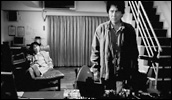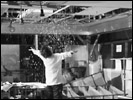Doppelgänger
- Year
- 2003
- Original title
- Dopperugenga
- Japanese title
- ドッペルゲンガー
- Director
- Cast
- Running time
- 107 minutes
- Published
- 15 April 2004



by Tom Mes
Doppelgänger shows us a Kiyoshi Kurosawa who is both noticeably different and very much the same. The difference lies in the film's positive tone of voice, expressed most clearly by the strong presence of comedy. This altogether more positive perspective appears to be a new phase in Kurosawa's career, one that started with his previous film Bright Future and that was preceded by a nearly two-year absence from filmmaking after Pulse.
That the turning point should have come after Pulse is not so surprising if we remember that this film took Kurosawa's destructive point-of-view as far as it could go, dragging us deep into the cold, dehumanised heart of an apocalypse that his previous films had merely hinted at. After this descent into the abyss, the title 'Bright Future' was chosen without a hint of irony. Despite still acknowledging the difficulties and hurdles in contemporary life and society, Bright Future was an honest statement, a genuine wish to move forward with a positive attitude.
Where Bright Future proved too oblique for many to grasp the changes in the director's attitude, Doppelgänger leaves little room for doubt. This is unmistakably a comedy. What's more, it will probably come as a shock to many to see a Kiyoshi Kurosawa film end with a shot of two lovers walking hand-in-hand into the sunset. And again, there is no irony or cynicism present in this image whatsoever.
The two short films he made subsequent to Doppelgänger confirm the fact that this positive outlook truly constitutes a new phase in Kurosawa's work. The first was the silly and self-parodic Rei Deka ('Ghost Cop'), an entry in Makoto Shinozaki's ongoing Cop Festival (Deka Matsuri) project of 10-minute comedy shorts. The second is a 23-minute DV essay commissioned by the PIA Corporation (also responsible for the long-running PIA Film Festival, a bastion for young filmmakers that launched Kurosawa's career back in 1980) and paid for by a saké brand. This short, entitled Soul Dancing (Kokoro, Odoru) is a kind of inverted Yojimbo, with a nameless stranger (played by Tadanobu Asano) coming to town to spread love rather than death and to unite two tribes instead of playing them against each other in strife. It too ends with two lovers marching off hand-in-hand into the distance, and with Love (i.e. Asano) moving on to its next destination.
For all the changes, Doppelgänger still treats similar themes along similar lines as Kurosawa's work of past years. Chiefly among these is the question of what defines an individual's identity. The doppelganger motif, which already appeared in his 2000 made-for-TV film Séance that also starred Yakusho, is merely another bend in the route the director has walked for quite some time, Cure's persistent hypnotist and Charisma's prized tree being two earlier examples. The extensive use of split screen, expanded from Bright Future, finds very fertile soil here as the stylistic extrapolation of this motif, and Kurosawa uses it very inventively to play around with definitions of individuality. Who are we looking at, protagonist Hayasaki or his double? And is there a difference between the two in the first place?
Doppelgänger's story of an over-stressed scientist working on the invention of a mind-controlled bionic wheelchair for the disabled, is packed with interlocking questions about our identity and what we derive it from: the sudden appearance of the scientist's meddling, amoral doppelganger is the personification of this question, but so is the wheelchair, whose function is after all to replace the human body, or to "replicate the complexity of human behaviour" as Hayasaki puts it. Even the basic plot structure, with its sudden destruction of an old environment to allow for the redefining of the protagonist's values and self-image, is virtually identical to nearly all of Kurosawa's films since 1997's The Revenge - A Visit from Fate (Fukushu - Unmei no Homonsha).
In fact, even comedy isn't new to the Kurosawa universe. More subtle in recent years, it was very overtly present in his V-cinema work of the early 90s, such as Yakuza Taxi (1993) and the six-part Suit Yourself or Shoot Yourself! (Katte ni Shiyagare!!) series starring Sho Aikawa (1995 - '96). Doppelgänger has many similarities in particular with the fifth entry in the Suit Yourself series, The Nouveau Riche (Katte ni Shiyagare!! - Narikin Keikaku, 1996). The cyclical structure of recurring events that formed the basis of that film's plot is reused in the final 30 minutes of Doppelgänger, in which various characters appear and reappear to try and thwart Hayasaki's plans for the future of his invention.
It's this characteristic of Doppelgänger being similar but different to his previous work which shows us that Kiyoshi Kurosawa is still far from finishing his development as an artist. Knowing the great heights he has already achieved, we can only conclude that the future is indeed looking very bright. For the director, but above all for his viewers.